Exhibition guide
> French version
![]() Teaching packs
Teaching packs
Exhibition guide
> French version
|
From 14 October 2009 to 8 March 2010
|
|
|
|
|
|
Painting 202x452cm, 29
June 1979 |
Exhibition
Painting not
depicting
A French painter in
the New World
Painting without
lyricism
The three ways of
black
Imposing
nothing on the material
The art
of do-it-yourself
Primitive
values
Painting
and asceticism
The
place of the beholder
Bibliography
Around the
exhibition
Pierre Soulages, the “painter of black and light”, is recognised as one of the major figures of abstract art and the greatest painter of the current French scene. This retrospective exhibition gathers together over a hundred works, created from 1946 to the present day, from the astonishing walnut stain paintings of the years 1947-1949 to the paintings of recent years.
In 1979, Pierre Soulages, who had already been painting for over thirty years, embarked on a new phase of his work which he termed Outrenoir [Ultrablack]. By concentrating on one colour, black, and its relationship with light, he constructed a pictorial space that – despite his reliance on one single colour – stands opposed to the monochrome in the development of modern art. The exhibition thoroughly explores this “other painting” in all its diversity. In the final section, the recent large multi-panelled paintings are freely suspended within the exhibition space.
This information pack proposes to approach Soulages’ work according to the themes (or aesthetic arguments) which brought it to prominence, and to attempt to summarize the various interpretations to which it can give rise.
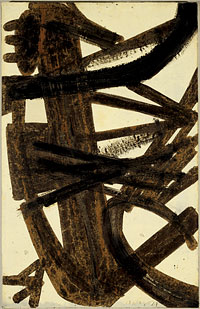 Walnut stain and oil on paper, 74x47.5cm, 1947
Walnut stain and oil on paper, 74x47.5cm, 1947
For his first
exhibition in 1947 Pierre Soulages showed his walnut stain paintings at the Salon
des Surindependants, where his compositions consisting of bold brown
strokes stood out from among the post-war neo-fauvist painting on show and attracted
immediate attention. They won him the admiration of Hans Hartung's wife and a
meeting with the artist himself, with whom he was to form a lasting friendship.
They also caught the sharp eye of Francis Picabia who
saw him later at the Galerie Drouin and repeated what Pissarro had said to him
about himself: “With your age and with what you do, it won't be long before you
have a lot of enemies!” In itself, using a cheap medium such as walnut stain made
sense in those poverty-stricken times. Yet, beyond the materials used, the
very asceticism of his constructions, the radical sobriety of his movements and
the restrained energy contained in them, drew praise. To this day his painting
remains faithful to this same economy of means, which is sometimes seen as
expressing serene gravitas or a life force stripped of sentimentalism.
Painting which represents nothing
Pierre Soulages’ paintings represent nothing. Like many abstract painters of his generation, he likes to say “that he doesn't depict” but “that he paints”. “He doesn't represent, he presents.” [1] His canvases were at the centre of the debates which shook the art world of the time about the links between abstraction and reality. The setting for this debate had already been laid some time before in the 1920's when Vassily Kandinsky collected photographs, engravings and drawings of abstract forms found in nature: images of bacteria seen under the microscope, constellations seen through a telescope, animal tissue seen through a magnifying glass, mineral structures; but also urban networks, boat frames under construction and cross sections of building work… When Jean Bazaine, a member of the “Young France” group, organised the exhibition entitled Twenty young painters of the French tradition under the Occupation, which brought together non-figurative painters such as Estève, Lapicque, Le Moal, Manessier, Pignon and Singier, he objected to the idea of abstract art. According to him, figurative painting is abstract and vice versa, as the perceptible reality is never only perceived through a human filter. [2]
The figure of the tree
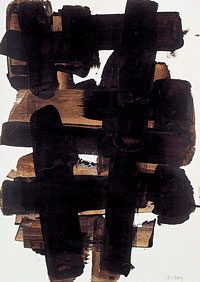 Walnut stain, 1959
Walnut stain, 1959
Walnut stain wash on paper, 76x54cm
Pierre Soulages says he started painting trees and their bare branches from the age of seven, and his interest in the abstract patterns created by the crossing of vertical and horizontal lines derived from the figure of a tree. The same was later true of Piet Mondrian and Jean Bazaine. From this figure, Mondrian drew his orthogonal grid while Bazaine turned it into a flexible grid perforated by shafts of light filtered by branches. Soulages, on the other hand, never represents the silhouette of the tree. He extracts its structural energy and the way the vegetable structure fills the surrounding space.
A vertical trunk rises upwards as one solid piece with its branches spread horizontally. Their joins are never the same, they never form a right angle and their formation is determined by the force of gravity acting on them. In the abstract relationships formed by the broad lines of Walnut stain (1959), we find an organic character derived from this figure of the tree. Their leaning gives rise to supple intersections despite the underlying suggestion of a geometric grid. They interact with the edges of the paper without ever going over the edge, they adapt to the defined format, and they occupy the space like the branches of a tree spreading over the largest possible area to bask in a maximum of life-giving light. The two vertical strips, which carry the composition, diverge as they rise and fan out at the top, producing an impression of elasticity. The fact that the left hand strip is interrupted prevents the effect of symmetry from taking over.
Thus, all the strips are incorporated into the paper itself: “A black tree in winter is a kind of abstract sculpture” says Soulages, “what interested me was the lines of the branches, their movement in space...” [3]
The presence of the work
A set of lines forming a single body in the middle of a white page automatically brings calligraphy to mind. Soulages wrote on the subject of his first walnut stain paintings: “I made line combinations which struck the eye of the beholder as a large form, a large sign which you could take in at a glance and one fine day I realised that the drawings I was doing were reminiscent of Chinese characters”. [4] Yet his painting does not refer to the figurative image of a tree any more than it does to an ideogram. To see his walnut stain paintings as Chinese characters would be to impoverish one's appreciation of them. They are neither figures, nor signs, nor symbols which we find in his painting, but an attempt to be completely open to meanings, an illumination of the principles of balance which govern the world. “Neither sign nor thing, but answering with the world”, wrote Henri Meschonnic in an essay dedicated to the painter. [5] Not answering “to” the world, but handing back the image of his very structure, without intermediary: replying to a presence with a presence.
Pierre Soulages’ painting is without words. While the artist has given numerous interviews, he has in fact written very little about his work. Indeed words are powerless to convey the materiality of his work, which is the whole purpose of his production: the nub is in the viewer coming face to face with the canvas, in his confrontation with the material and in the experience of its presence. “Painting is the absent state of words.” [6] For this reason, his paintings which represent nothing cannot be described with literary images. One could not speak about the large dark strips which crisscross his canvases by evoking “steles of silence”, or “fallen beams”, “nocturnal architectures” or “battlegrounds between the shadow of ashes and the light of rebirth”. It would be to impose an interpretation and indulge in a “poeticisation, that mixes […] sentimentality with painting [and assimilates] the abstract to the figurative”. [7] For this same reason, none of his works bear a title, each one being identified merely by its dimensions and the date of execution. For Soulages, “a painting is an organisation, a set of relationships between shapes, lines and coloured surfaces, on which the meanings which we give it are made and undone.” [8]
A
French painter in the new World ![]()
Abstraction: a political issue
There is no denying that Soulages’ work was exhibited abroad very early on, notably in Germany − in 1948, one of his paintings was used for the poster of the exhibition Französische abstrakte Malerei − and even more so in the USA before it became known in France. From an American point of view, supporting a painter like Soulages was to support young abstract painting in Europe against the prevailing figurative tradition in post-war France.
However, this point of view masks a more fundamental political issue. Conceived in New York in the mid-1940’s with such leading artists as Jackson Pollock and Willem de Kooning, abstract expressionism was actively supported by the American government during the war − until the end of the 1950’s − as the model of an ideology which could be extended to the whole of the Western world, a buffer against socialist realism and its associated values. The involvement of MoMA in America’s foreign policy during this period was considerable. In 1952, the Museum set up a program for the international diffusion of abstract expressionism, indirectly financed by the CIA whose agents provided help in staffing exhibitions abroad. [9]
Supporting artists like
Pierre Soulages also meant imposing the new generation
of American artists on national and international markets, by according him the
appreciation still given to European and particularly French artists. The
resolve to establish this affinity was present from the earliest exhibitions of the painter in the USA, such as those organised by Betty
Parson, Pollock's New York gallery owner, Painted in 1949, European and American Painters.
Many critics
followed the example of Clement Greenberg with his nationalist vision of art, and didn't hesitate to present the American painters as
forerunners of their European counterparts, who were less energetic and held
back by the weight of tradition. Large formats exalting the wide open spaces of
the New World − whether one thinks of deserts in
the case of Jackson Pollock or of cityscapes with Franz Kline − were to be the hallmark of this painting.
Apart from the galleries, Soulages received the notable support of James Johnson Sweeney, curator at the MoMA from 1935 to 1946, then at the Guggenheim, New York, from 1952 to 1960. In 1951 he took part in the travelling exhibition Advancing French Art, in 1953 he participated in the exhibition Younger European Artists at the Guggenheim Museum and in 1954 he took part in The New Decade at the Museum of Modern Art. Without rejecting national differences, Sweeney spotted the originality of his approach early on and never stopped defending his work for the freedom it imparted to geometric abstraction. Indeed, his painting is not to be judged by the standards of abstract expressionism, nor even of gestural abstraction, American or otherwise: Soulages does not paint movement, he arranges contrasts to bring forces into play.
“Removing the trace of movement from the line.”
At first glance, Pierre Soulages’ work confronts the viewer head-on. The idea is important in the artistic context of the early days of gestural abstraction: his painting has no lyrical side. It stands out from among the approaches in French abstract art of his colleagues and friends, Hans Hartung, Georges Mathieu, Gerard Schneider, the early works of Jean Degottex, and from American abstract expressionism. James Johnson Sweeney summed him up neatly by saying: a painting by Soulages is not a melody, “it's a chord played on the piano and held”. [10] In other words, Soulages seeks to “remove the trace of movement from the line”. [11]
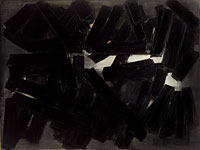 Painting 200x266cm, July-August 1956
Painting 200x266cm, July-August 1956
Oil on canvas
As we see in Painting 200x266cm, July-August 1956, the canvas area is organised to be perceived as a block, to call up an instant overall impression. The traces left by the painter’s gestures do not form an itinerary to be followed. They do not invite the viewer to retrace the movements of the painter in action, trying to communicate some emotional impulse. Each gesture is placed as a necessary gesture to form the structure and framework of a composition. There are no paths, no routes to follow, no thread or narrative to retrace in this painting. The strokes are laid out in short bands placed on top of one another. The time spent looking at the canvas does not follow any sequence, it is all surface. “Time seems to me to be central in my work as a painter”, declares Soulages. “I prefer paintings where time is there, motionless, hanging in the picture, as motionless as the stretcher and the canvas! In other words, a form of time suspended in the passage of time.” [12]
Between gestural and geometrical abstraction
In this canvas from July-August 1956, the short strips of paint correspond to the search for a balance between gestural and geometrical abstraction: drawn using a soft palette knife, the strokes form irregular parallelograms of a sort. The elements are geometrical but the outlines are random. Thus Soulages’ painting embodies neither the warm imprint of gestural abstract art, because of its geometrical element, nor the coldness of geometrical abstract art, because gestures are incorporated. Neither cold nor warm, neither rigid nor soft, neither legible nor illegible: it stands at the junction of both, in constant balance. Following this same principle, these bands are distributed over two distinct rows, while at the same time being gathered in little groups. Their way of interlocking confronts the viewer with an assemblage which keeps a balance between order and disorder. “One is always dogged by two equally dangerous things: order and disorder”, [13] explains Soulages.
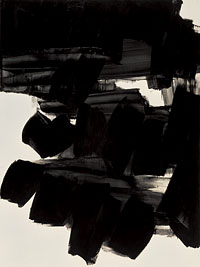 Painting 260x202cm, 19 June 1963
Painting 260x202cm, 19 June 1963
Oil on canvas
Once again it is his refusal of lyricism which impels Pierre Soulages to use tools which do not betray the thick and thin parts of the stroke: wide brushes with flat square ends, house-painting brushes. Painting 260x202, June 1963 is made up of wide swaths of black paint, laid down in places with a soft scraper and elsewhere with this type of brush. The legibility of the composition, the simplicity of the elements, the verticality and size of the format, give the work a monumental impact. Relationships of stark contrasts stand out, divided into zones covered in intense black and others where the white of the primer shows through. The lightest coats of paint are covered by the darkest layers, yet they seem to be in the same plane. Our next impression is one of balance: although the surface occupied by black is greater than that allotted to white, the influence of the white is so intense that the space seems to be equally distributed between the two.
The fact that the painter's entire attention bears on the overall structure and not on the expressive dimension of the gestural trace can be seen in the smallest details. When we look closer at some of the small vertical swaths which cover the canvas, we notice that the paintbrush has passed over several times. These added touches indicate that he is more interested in obtaining an intense black and a certain sense of visual balance than in expressing the energy contained in a gesture.
“Black never exists in the absolute.”
For over sixty-five years, Soulages’ work has used all possible variations of the colour black and for the last three decades, black has even come to completely cover his canvases. Yet, the colour black, according to him, “never exists in the absolute”. Its intensity changes with the dimensions of the surface, its form and its texture. With hindsight, Soulages has identified the various uses of black which mark his work and which he calls the “three ways of black”.
“In my painting, dominated by [black] from my childhood up to now, I can objectively distinguish three ways of black, three different fields of action: Black on the ground, a stronger contrast than that with any other colour to illuminate the light parts of the ground; [Black associated with] colours, first hidden by the black, then in places seeping out from the canvas, exalted by the surrounding black; The textural black (with or without a sense of direction, energising the surface or not): the material is a matrix with changing reflections.” [14] Yet, these three ways do not really correspond to three precise periods of his career. Soulages switches from one to the other, sometimes exploring them simultaneously, putting more or less emphasis on one or the other in his different periods.
So the blacks on the ground were the main area of his research during the 1960’s and 1970’s. The textural blacks refer especially to the series of the Ultra-blacks, dating from 1979 when he began to cover the whole surface of his canvases with a thick coat of black paint. This series endows the material of his canvases with a sculptural dimension which was foreshadowed in his earlier work. Similarly, his blacks with colours, developed in his earliest work, have made their reappearance in his latest work, where he uses blacks with ultramarine blue.
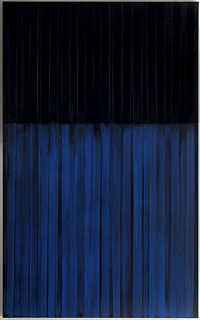 Painting 222x137cm, 3 February 1990
Painting 222x137cm, 3 February 1990
Oil on canvas
In Painting 200x162cm, 14 March 1960, we can see
how well the use of black with a second colour, diluted
or scraped thin, underlines its clarity, producing as it were an effect of
stained glass in its lead surround. Light passes through the thin membrane
of coloured paint to be reflected by the white of the canvas and escape back
through it. The surrounding blacks thus become denser. The effect of contrast
is just as striking in Painting 222x137cm,
3 February 1990, with its shades of blue where the coloured areas retreat
inside a rectangular frame reminiscent of a window. In Painting 202x143cm, 22 November 1967, the black is no longer
treated as a frame as it covers nearly the whole surface, all but burying a
brown area whose reduced size makes it all the more conspicuous.
 Painting 300x235cm, 9 July
2000
Painting 300x235cm, 9 July
2000
Oil on canvas
Painting 300x235cm, 9 July 2000 places the equivalent elements
between different ways of black side by side. On one side, grooves are
arranged in the actual material of the painting to create textural blacks with shades of grey created by the incident light. These greys find their echo
in the contrasts of the black on the ground of the other side. The
canvas is almost didactic and the retrospective intent is very clear: the artist
builds a bridge, or in contrast a frontier, between two aspects of his work.
imposING
NOTHING ON THE matERIAL ![]()
Soulages' pieces present a number of visual paradoxes: black gives birth to light, what withdraws acquires prominence, the shrinking of a form makes it more visible, down becomes up, out of the void emerges fullness… Thus we find a profusion and confusion of material realities that are belied by the words which describe them. In this respect one can compare his approach to painting with the fundamental principles of the Tao teh ching [15]. As his work speaks of the silence of the world, what it says is true because it says nothing. We almost hear in his painting an echo of the precepts of the legendary Lao Tzu expounding the principle of the Tao: “ Being and non-being come from a single ground / and are only distinguished by their names. / This single ground is called Darkness. / To darken this darkness / that is the gate of all wonder.” [16]
The act of painting rooted in the material
Soulages's interest in Taoist thought is not corroborated by any declaration from the artist. Apart from his regularly stated interest in ancestral cultures and his occasional participation in the activities of the German group Zen 49, which led to the exhibition of that name at the Baden-Baden Kunsthalle in 1986, the affinity of his approach with oriental culture is to be inferred essentially from the claims he makes in describing the act of painting. [17]
Soulages’ perceived need never to impose his will on the material echoes the necessity expressed by the Tao never to impose one’s will on the world. Soulages imposes nothing on the material, he moves along with it. Emptying oneself of self so as to be filled with the ceaseless movement of the world, as embodied in the act of painting. From this follows the impression which he often mentions of simultaneously obeying the dictates of the medium, the canvas and the chosen tools as he paints. The empathy with the materials used is such that the artist seeks only to bring out what the materials themselves demand of him.
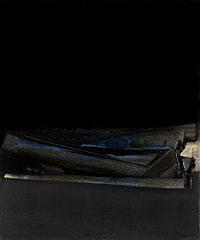 Painting 55x46cm, January 1960
Painting 55x46cm, January 1960
Oil on canvas
In Painting 55 x 46cm, January 1960 for example, the viscous body of the paint has determined the manner of its application. Excess paint on either side of the soft palette knife used by the painter forms a ridge around each swath. That is the idea: to work in anticipation of the reactions of the material, respecting their plastic properties so as to be able to follow their direction. Never to restrict the desires of the material. Soulages said of it: “I love the act of painting rooted in the material”. “I learn what I am looking for from what I do.” “When I began painting, I used to think you had to have your picture in your head before executing it, but I found out that painting from your head is very bad. […] Painting is an exercise in freedom.” [18] This freedom and this feeling of plenitude are the fulfilment of the precepts of Tao: “Acting without planning anything / guiding without forcing, is the summit of virtue.” “Know the white. / Yet, keep to the black. / Be a pattern for the world. / To be a pattern for the world ... is to find the infinite.” “[The sage] discovers the raw block of wood. / The block of wood, carved along its grain, forms the tools.” [19]
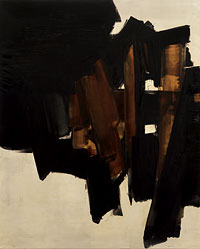 Painting 200x162cm, 14 March 1960
Painting 200x162cm, 14 March 1960
Oil on canvas
To achieve this freedom, painting must emancipate itself from all projections of the imagination, for “figuration is the projection of ideograms, of mental things, imaginary and therefore limiting” [20] in view of the infinite richness of details offered by the very material of the work. The area of the canvas is not the representation of a figured space; it is its own space, with its own centre of gravity. Since the canvas is flat, it should stay flat to fulfil its own material nature.
With the aim of making his canvases exist on the surface, Soulages removes any sign which could suggest a horizon line. Some of his canvases, such as Painting 200 × 162cm, 14 March 1960, present the widest black surfaces in the upper part and more sparingly applied black surfaces in the lower part, as if the sky and the earth had changed places, thus preventing any projection. The diagonal construction follows the same reasoning. The gaze is drawn sideways instead of endowing the depths with an imaginary background. Everything depends on managing the internal balances. Here the swaths of coloured paint with their conspicuous lightness are kept to the right side to counterbalance the mass of black piled up in the left half. In this top heavy composition, the artist compensates the imbalances by insisting on the directional movement of the large vertical swaths which stretch downwards like ballast. In addition, the large white area at the bottom left-hand corner finds its echo in the small white area at the top right-hand corner, alleviating the overhanging black surfaces. The space thus becomes tangible in the interplay of tensions.
Beyond “clumsiness and skill”
Soulages claims to
reject elegance, preciousness, the fluidity of gesture and know-how in favour
of hesitation and the exercise of a perpetually renewed curiosity. He seeks the
raw, not the refined. “I am touched by things that are outside the realm of
clumsiness or skill”.
[21]
On this subject, he often recals the sight of a cracked window in the Gare de
Lyon as the inspiration for later work. This broken window had been glued
together with tar by the workers, whose main concern was the solidity of the
result. It had caught his attention because its partial opacity made it no
longer open to the world, like a window brought back to life, and it could be
viewed as the canvas of a modern painter, as a surface. This pane of glass resembled
a clumsily executed stained glass window, stripped of pretence. The streaks of
tar followed the lines of the breaks, covering each other, emphasizing the motifs
already drawn in the glass when it broke. The “rudimentary brushwork”
[22] of the workers appealed to
him. Faithful to this memory, while his few post-war works of tar on glass, some
of them on broken glass
[23] , suggested the idea of a Europe
undergoing reconstruction, they also and above all form a tribute to the tangible
forces which the materials bring into play in their opposition. The opaque and wrinkled
tar, the smooth transparent glass are joined to highlight
their differences.
To each tool its's purpose
When Soulages began with his walnut stain paintings, the idea of using a poor material intended for staining wood and not for fine arts was what specially interested him. The use of tar follows the same logic. Soulages turns towards “robust, not pre-packaged materials” [24] . In the same way, from the point of view of tools, he prefers the housepainter's brush to the graceful paintbrushes sold in art shops. For him, “each tool brings with it a different nature of form and a different modulation of colour”, “each tool has its own purpose”. [25]
A brush cut diagonally presupposes its use for calligraphy with the interplay between thick and thin strokes: it carries within it a function which predetermines how it is used and reduces the painter's freedom. When he found himself in Tokyo in 1957 for an exhibition of his works, Soulages became aware of the various traditional Japanese paintbrushes. Out of all of them, the only ones to hold his attention were those called “trimmed grass” with their bristles cut flat and square. The brushes in question are not “calibrated for elegance and fluidity” as they are adapted to copying Buddhist texts and have the reserved spirit suited to the precepts they transform into calligraphy.
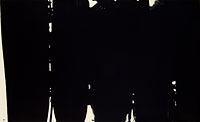 Painting 220x366cm, 14 May 1968
Painting 220x366cm, 14 May 1968
Oil and acrylic on
canvas
Aside from reclaiming builder's paintbrushes, he frees himself from all pre-packaged formulas by making his own tools. He designs his own painting knives from pieces of leather soles, rubber scrapers, old brushes stiff with dried paint, wooden sticks, split planks covered in splinters, and others covered in rags,... “The process is inseparable from the art which is born from it. In other words, the ground and the form are one and the same. I never stop inventing instruments, most often on the spur of the moment. When I can no longer produce something, I grab hold of whatever comes to hand.” [26]
In Painting 220x336cm, 14 May 1968, the large surface occupied by the five black planes highlights the random aspect of their outlines, leaving roughly dashed lines to appear between their generous masses. The tension between the black and white zones is essentially the result of the irregularity of these edges. It heightens the fragile survival of the remnants of white: had there been a little more pressure on the tool laying down the blacks they would have totally disappeared.
 Painting 202x452cm, 29
June 1979
Painting 202x452cm, 29
June 1979
Diptych
Oil on canvas
The Outrenoirs executed from 1979 onwards began with a day of fruitless effort at the end of which the artist abandoned the painting which he had spent a whole day labouring over. By covering over successive failures the whole of the canvas ended up saturated with black. The next morning, as he surveyed the result with his wife, she remarked that he had opened a new path. Painting 202x452cm, 29 June 1979 shows us how he undertook the work: not only is there only one colour now, but on top of that, there is only one tool used, one type of movement and one consistency of paint.
This polyptych, composed of two canvases of different widths joined in one, plays purely on the rhythm generated by the variation of format and the slopes of the brushstrokes. Soulages combs the material rather than painting with it. With his brush, he has made large horizontal gestures which stop exactly at the edges of the canvas or at the boundary of lines drawn in pencil beforehand. The different depths of the grooves carved by the tool are sources of infinite variations. More than the artist, it is the brush which expresses itself. This canvas breathes with the curiosity of each instant as opposed to the know-how of the artisan or the artist’s “tricks”.
This essential aspect of Soulages’ work seems to appeal to the famous passage about the idea of do-it-yourself written by the anthropologist Levi-Strauss at the very beginning of the 1960’s in La Pensée Sauvage. In it he compares two figures, two possible approaches to creation: that of the engineer and that of the handyman. Whereas the engineer plans a finalised idea of his work and goes off to find tools and materials to execute it, the handyman has no project in his head. On the contrary, what he will do is determined by the tools and materials which he has: he creates from what is at hand. As the work takes shape, the idea of the end result becomes clearer, and will only be fixed once the process of creation has ended.
“The handyman is apt to execute a large number of diverse tasks; but, unlike the engineer, he does not subject each of them to the precondition of obtaining the raw materials and tools specified in his project: his instrumental universe is closed and the rule of his game is always to make do with what he has ‘on board’. In other words, at any given moment a finite set of tools and materials, and a miscellaneous collection moreover, because the makeup of the set is not related to the project of the moment, nor indeed to any particular project, but is the incidental sum of all past occasions for renewing or adding to the stock or maintaining it with leftovers from previous constructions and destructions. The set of facilities available to the handyman is therefore not defined by a project.” [27]
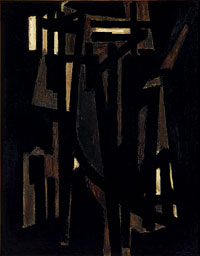 Painting 146x114cm, 1950
Painting 146x114cm, 1950
Oil on canvas
When Soulages arrived in Paris in 1938 to become a teacher of drawing, his knowledge of art history was limited to what he had acquired at college in Rodez: he admired the works of Claude Lorrain and Rembrandt for the rendering of light and, as regards the latter, for the impasto treatment of bodies. At the time, he was advised to try the national competitive entry exam for the Beaux-arts (Fine arts). He was admitted but never went to the lessons. During his stay in Paris he discovered Picasso and Cezanne and was a regular visitor to the Louvre. Called up in 1940 and demobbed a year later, he studied painting at the Beaux-arts in Montpellier.
During this period, Soulages knew little about abstract art, which was neither taught nor really exhibited in France. The values of French art at the time were associated with the figurative works of such artists as Dunoyer de Segonzac, Fougeron or Pignon. He discovered abstract art at his barber’s during the war in an edition of the Signal magazine dedicated to degenerate art. He saw reproductions by Mondrian and Kandinsky for the first time.
A personal art history
Aside from this chance but decisive encounter, the artist continued to refer to sources of inspiration which fell far outside the historical context of the twentieth century. His personal art history goes back over 160 centuries. He claims that his black, his ochres and his reds are those of the cave murals of Pech-Merle, Font-de-Gaume, Altamira, and Lascaux, discovered in 1940. Admittedly he was interested in the mural art of his native region from an early age, but this vision, which transcends the history of art, can be seen in the light of cultural context marked by the primitivism of the early twentieth century avant-gardes, whose voices are still heard today. In short, when Soulages returned to Paris in 1946 to dedicate himself to painting and when he met the Algerian painter Atlan, with whom he became friends, it was not by chance that the two painters found common threads in their work.
Jean-Michel Atlan, who had recently left Sainte-Anne Hospital where he had got himself interned to avoid deportation, was drawn to the Cobra movement, ostensibly deriving his approach from primitive art as a way of opposing the Western rationalist culture. Soulages’ work, on the other hand, shows no direct relationship to African statuary. Yet, through his search for universality, reflected in the economy of material means and symbolic signifiers, it can be perceived as embodying the dynamic and materialist spirit of the American New World, or conveying oriental precepts, or even the values of black Africa.
“Form and ground are one and the same”
It was this possibility of identifying Soulages’ work with the values of black identity which, in 1974, led Leopold Sedar Senghor to put on a retrospective exhibition of his work in Dakar's newly inaugurated contemporary art museum, the Musée Dynamique. This important exhibition was to travel from Dakar to Caracas, via Madrid, Lisbon, Montpellier, Mexico, Rio and São Paulo.
Indeed the brown, ochre, red and black, the warm dark earth colours that he uses also correspond with the colours of Africa, to its burnt woods, to its terra cotta crafts. Soulages explains: “The materials [which I use] are close to what I feel fraternally related to: the earth, stones, old wood, tar, rusty iron […] I have always preferred them to smooth, plain-coloured, pure and lifeless materials. […] This roughness also contains great subtleties”.
Soulages also shares with Senghor this idea that ground and form are like body and soul: man thinks with his body and not, as in the West, by separating himself from it. Thus the mere image of these materials invites meditation, but sensual meditation. Faced with such a painting, Man rediscovers, in an instant, the aesthetic experiences which bind him to the Earth. The random character of the formal layout, the fact that Soulages sculpts the paint in the mass, carving out furrows, all the perceptual indications coincide. Thus each form is thought out, “form and ground are but one and the same”, “the relationships between the forms are a transfer of the relationships of the universe with other meanings”. [28] In this sense the physical impressions produced by his canvases, their way of organising forms, of slowly taking on a structure, the attitude adopted by the painter to bring his compositions to fruition, all of that communicates and constitutes a structural model for thought.
The art of laying bare
The continuity of Soulages’ artistic progress, the constancy of his research into bringing out the light in black even in the thickness of the material, justifies the description of his work as an obstinate quest in working on light [29] . The myth which he builds around his vocation, in his many interviews, corroborates this idea. As, while Soulages claims his origins in the carbon of cave drawings, he also draws from Romanesque architecture, which he discovered at the age of twelve on a school visit to the abbey church of Conques. Soulages remembers this episode from his past as a moment of revelation. His later work would aspire towards the light and sobriety of space which this architecture revealed to him.
The art of laying bare, of finding the right proportion in combining rectangular surfaces, fascinated him and aroused his first aesthetic emotions. The bare decoration of the Cistercian tradition was also of prime importance. The walls of Cistercian abbeys, whether in the Gothic or Romanesque style, are bare of all decoration, devoid of statuary, so as to leave room for the simple variations brought about by the light penetrating the spaces of contemplation. The windows are colourless so as not to alter the light of the heavens, varying with each hour of the day as its reflections play on the waxed flagstones of the floor. We find the central principle of Soulages art: showing little so as to highlight what there is to see.
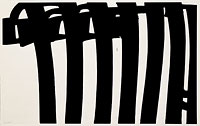 Painting 202x327cm, 17 January 1970
Painting 202x327cm, 17 January 1970
Oil on canvas
In Painting 202x327cm, 17 January 1970, the same motif is repeated seven times in a row, displaying variations in its shape. It seems to stretch out from left to right, or to reach out to the upper edge as it progresses. The successive shapes suggest a linear evolution in which the most graphically charged part tends to disappear literally through the heights. It should nevertheless be pointed out that the frequent repetition of gestures in Soulages' canvases does not so much aim to generate a rhythm, in the sense of an arrangement in time, as to cast each element's unique character in their successive and apparent similarity. The extreme simplicity of the repeated motifs reinforces this effect: pointing the finger at the infinite richness of reality, beyond the ingrained reflexes of a way of seeing conditioned by rational thought.
Ever simpler gestures
Pursuing this principle of laying bare, the evolution of his painting evinces an ever more concentrated quest for reducing the means employed. So it is that over the course of the 1960’s and 1970’s, the number and diversity of the gestures made by the painter on a single canvas diminish at the same time as the gestures increase in breadth. The image of his early compositions with their firm structures gives way to simpler gestures which of themselves structure the space which they inhabit. The compositions thus lose their centripetal character and gain in freedom of execution. Over the same period, more and more canvases present a widening of the black surfaces and a proportional shrinking of the white space. We then often find the distant image of the shafts of light piercing the penumbra of the Cistercian spaces for meditation.
The appearance of the artist’s two studios is often mentioned for the similarities which they bear to his work; as they form spaces which are always kept tidy, largely empty, and penetrated by a directional light suitable for contemplation. The house which he had built to his own design on the upper slopes of Sète has simple lines and keeps a low, unassertive profile within the landscape. The workshop, which he has installed below, catches the light without displaying those huge picture windows found in many artists' studios: the light enters in small doses; it is filtered to make it visible as such.
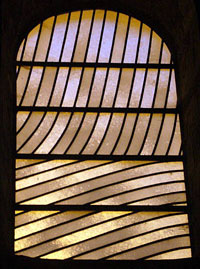 Conques Abbey, stained glass, 1987-1994
Conques Abbey, stained glass, 1987-1994
The abbey church of Conques, the place where Soulages found his vocation, is also the place where he consecrated his career. The stained glass windows commissioned by the State in 1986 were installed in 1994, after eight years of research. Wishing to place this work within the logic of his artistic development without thereby making the windows a mere extension of his painting, he decided not to make any preparatory drawings before having determined his material or rather having been determined by it. This material was a colourless glass whose translucency could be modulated. This glass did not yet exist, but he had it made for the occasion.
Intended for the abbey's 104 openings, Soulages’ windows are made up of large bands of untinted glass. These bands have gradations of variable opacity present in their very thickness. Thanks to the material, translucent and not transparent, the openings give the appearance of surfaces which are their own source of light. The parallel bands have the same width and are grouped in horizontal compartments. Their sloping angle and their curvature vary depending on their position in the window, producing, more often than not, an effect of upward tension. Seen from inside in the evening, the panes can simultaneously take on different red and yellow hues on one side and blues and greens on the other. Seen from outside, they reflect the light of the sky like so many opaque mirrors, becoming as impenetrable as the stone façade. It is a factor which Soulages was very interested in, as his windows were made to be seen from both sides: thus the yellow on the inside can look blue on the outside, as it reflects the sky. Once again, by reducing the means employed and letting the environment play its part, he reveals the infinite richness of light.
The relationship artist-work-viewer
For those who want a religious reading, this richness appears as a proof of divine prodigality. However, just like when we tried to assimilate Soulages’ work with the values of the New World, black Africa or the Tao, foisting on his work an affinity with the Christian religion is purely a matter of interpretation. It is not integral to the work. For Soulages, the meaning of the work is developed in the three-cornered relationship between the artist, the work and the viewer. It is not the artist who makes the work; the work is conceived in a dialogue with the artist, and the meaning of the work in its dialogue with the viewer. Beyond this, these three instances construct each other reciprocally: the artist is constructed by his work and the viewer constructs the meaning of the work and is constructed by it in return.
As if “inside the space he creates”
Whether he is working with the transparency of the windows or the reflections of the black material on the surface of his canvases, Soulages progressively arrives at painting directly with light. In his Outrenoirs, he obtains greys and flashes of white just by using the effects of the raised patterns in the gloss of the oil and, later, the acrylic surface. It is not a question of impressing the viewer with a multitude of dazzling reflections, but rather to draw the attention to discreet, contained phenomena. It is no longer a question of bringing out the contrasts of the confrontation between black and white on the canvas, but of presenting contrasts which shift with the viewer’s position.
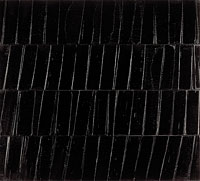 Painting 324x362cm, 1985
Painting 324x362cm, 1985
Polyptych C (4 elements
81x362cm, vertically stacked)
Oil on canvas
In this polyptych, with its elongated vertically stacked panels, the painting features a sequence of gestures repeated in a fixed order. First of all the large horizontal strokes are produced using a brush or the irregular fibres of a broken plank of wood. Then, a smooth scraper is used to flatten the reliefs obtained in a series of parallel vertical movements, more or less sloping depending on the panels. The work plays on the repetition and the rhythm born from the distances between each motif, like basketwork in paint.
The greys generated by the light create patterns in the composition. As the viewer changes position, what was a light line on a dark surface may go into reverse and become a dark line on a light surface. Soulages’ paintings somehow ‘follow’ the viewer as he moves around. It is the onlooker who feels looked at: the canvas and the viewer form part of the same space, he is included in the space of the canvas and it internalises his position.
Commenting on Cimabue’s Madonna in Majesty to some friends visiting the Louvre with him, Soulages explained the mechanism of this effect. This work presents a sky of gold, “which means that, more than a colour, it is an effect, a light which goes from the painting towards me as I watch it.” The viewer is thus “on the inside of the space he creates”, the canvas is not somewhere other than the image; it is fully in the real world.
[1] Françoise JAUNIN, Noir lumière, interviews with Pierre Soulages, Lausanne, éditions La
Bibliothèque des arts, 2002 ![]()
[2] Jean BAZAINE, Notes
sur la peinture d'aujourd'hui, Ides et Calandes, 1948 ![]()
[3] Françoise JAUNIN, Noir lumière, interviews with Pierre Soulages, op. cit. ![]()
[4] Françoise JAUNIN, Noir lumière, interviews with Pierre Soulages, op. cit. ![]()
[5] Henri MESCHONNIC, Le rythme et la lumière avec Pierre Soulages, Odile
Jacob, 2000 ![]()
[6] Françoise JAUNIN, Noir lumière, interviews with Pierre Soulages, op. cit. ![]()
[7] Henri MESCHONNIC, Le rythme et la lumière avec Pierre Soulages, op.cit. ![]()
[8] Pierre SOULAGES,
Catalogue de l’exposition Grosse Französischer abstrakter Malerei Ausstellung , 1948 ![]()
[9] See Frances Stonor
SAUNDERS, Qui mène la danse? La CIA et la
guerre froide culturelle (Who Paid
the Piper), éditions Denoël, Paris, 2003 et Serge GUILBAUT, Comment New York vola l’idée d’art moderne,
éditions Jacqueline Chambon, Nîmes, 1996 ![]()
[10] James JOHNSON SWEENEY, Soulages, éditions Ides et
Calendes, 1972 ![]()
[11] Françoise JAUNIN, Noir lumière, interviews with Pierre Soulages, op. cit. ![]()
[12] Henri MESCHONNIC, Le rythme et la lumière avec Pierre Soulages, op.cit. ![]()
[13] Françoise JAUNIN, Noir lumière, interviews with Pierre Soulages, op. cit. ![]()
[14] Henri MESCHONNIC, Le rythme et la lumière avec Pierre Soulages, op. cit. ![]()
[15] Legend has it that the Tao teh ching was
written between 600 and 400 BC, but it was more likely written between 206 and
220, in the Han era. ![]()
[16] LAO TZU,Tao Teh Ching, translated Liou Kia-hway, Paris, éditions Gallimard, 1967, p 26 and p.11 ![]()
[17] Note that the Tao was present from the beginnings of
abstract art, in a short passage quoted by Malevitch as the inspiration for his
black square, which he wished to imbue with an organic character: “The Tao is a
large square without angles, a loud sound which cannot be heard, a large image
which has no form.” (Kasimir MALEVITCH, Ecrits sur l'art, volume 4: La
Lumière et la Couleur, textes inédits de 1918 à 1928, L'Âge d'Homme, 1993) ![]()
[18] Françoise JAUNIN, Noir lumière, interviews with Pierre Soulages, op. cit. ![]()
[19] LAO TZU, Tao Teh Ching, op. cit, p.21/44 ![]()
[20] Françoise JAUNIN, Noir lumière, interviews with Pierre Soulages, op. cit. ![]()
[21] Pierre SOULAGES, interview
with Pierre DUMAYET, Le Figaro Littéraire,
30 March 1967 ![]()
[22] Bernard
CEYSSON, Pierre Soulages, éditions
Flammarion. Paris, 1979 ![]()
[23] See Serge GUILBAUT,
« Pierre Soulages, l’Américain à Paris », Soulages, éditions Centre Pompidou, Paris, 2009 ![]()
[24] Françoise JAUNIN, Noir lumière, interviews with Pierre Soulages, op. cit. ![]()
[25] Françoise JAUNIN, Noir lumière, interviews with Pierre Soulages, op. cit. ![]()
[26] Pierre
SOULAGES, « Interview with Pierre
Soulages », Le Point, 31 March 2003, n° 1585 ![]()
[27] Claude LÉVI-STRAUSS, La Pensée sauvage, Paris, éditions
Plon, 1960, p.27 ![]()
[28] Françoise JAUNIN, Noir lumière, interviews with Pierre Soulages, op. cit. ![]()
[29] Eric de CHASSEY,
« Conques, une abstraction épiphanique », Soulages, éditions du Centre Pompidou, Paris, 2009 ![]()
BOOKS
Under the direction of Alfred PACQUEMENT and Pierre ENCREVE, Soulages, exhibition catalogue, éditions du Centre Pompidou, 2009Pierre ENCREVE
> Soulages. L'Œuvre complet, 3 vol. (1946-1958, 1959-1978,
1979-1997), Paris, éditions du Seuil, 1998 (catalogue raisonne de 1 174 works)
> Soulages. Les Peintures. 1946-2006, Paris, éditions du Seuil, 2007
> Soulages : 90 peintures sur papier, Paris, éditions
Gallimard, 2007
> Soulages, l'œuvre imprimé, Catalogue raisonné, éditions Bnf, Paris,
2003
Bernard CEYSSON, Pierre Soulages, éditions Flammarion, Paris, 1979
Pierre DAIX, Pierre Soulages, éditions Ides et Calendes, 1991
Henri MESCHONNIC, Le rythme et la lumière avec Pierre Soulages, Odile Jacob, 2000
Françoise JAUNIN, Noir lumière, interviews with Pierre Soulages, Lausanne, éditions La Bibliothèque des arts, 2002
Hubert JUNE, Soulages, le musée de poche, Paris, éditions Georges Fall, 1958
Jean-Michel LE LANNOU, La Forme souveraine. Soulages, Valéry et la puissance de l'abstraction, Paris, éditions Hermann, 2008
Michel RAGON,
> Soulages, les peintures sur papier, Paris, éditions Hazan, 1962
> Les Ateliers de Pierre Soulages, Paris, Albin Michel, 1990
Nathalie REYMOND, Soulages, la lumière et l’espace, Paris, éditions Adam Biro, 1999
Connor RUSSELL, Pierre Soulages: au-delà du noir, translated by Stephanie Molinard, Paris, éditions Alvik, 2003
James JOHNSON SWEENEY, Soulages, éditions Ides and Calendes, 1972
James JOHNSON SWEENEY / Pierre DAIX, Pierre Soulages, L'œuvre 1947-1990, éditions Ides and Calendes, 1990
ARTICLES
Christophe DONNER, “Entretien avec Pierre Soulages”, Le Monde 2/3 February 2007
Françoise JAUNIN, “Pierre Soulages, lumières d'outrenoir”, official site of the French Foreign Affairs Ministry
Pierre DUMAYET, “Entretien avec Pierre Soulages”, Le Figaro Littéraire, 30 March 1967
Jean PIERRARD, “Entretien avec Pierre Soulages”, Le Point, 31 March 2003, n°1585
Pierre SOULAGES, “Réalisme et realité”, study by Camille BOURNIQUEL, Esprit, n°168, June 1950
INTERNET LINKS
• On the Centre Pompidou website. Video : Un
dimanche, une œuvre (One Sunday, one work) Pierre Soulages, 30 March 2008. Peinture,
324x362cm, Polyptyque C, 1985 ![]()
• Pierre Soulages official information website ![]()
• “Lumière en noir et lumière tangible - Le ‘goût’ du paradoxe”,
by Marie Renoue ![]()
• Virtual visit to the Abbey church of Conques ![]()
• Guided tours
• Disabled visitors tour
• Colloquium ‘Pierre Soulages’
• Multimedia guide
• Catalogue, Album and DVD
• To know more: consult the exhibition diary page ![]()
To browse other information packs on the exhibitions
and collections of the National Museum of Modern Art
In French ![]()
In English ![]()
Contacts
In order to provide you with the best service, we would like to know your reactions
and suggestions concerning this document.
You can contact us via our website, on the section Contact, subject education ![]()
Credits
© Centre
Pompidou, Direction de l’action éducative et des publics, January 2010
Text: Norbert Godon
Works by Pierre Soulages © Adagp, Paris 2010
Photographs by Jean-Louis Losi and François Walch © Adagp, Paris 2010
Layout: Michel Fernandez
File on line at
www.centrepompidou.fr/education
rubrique ’Dossiers pedagogiques’ ![]()
Coordination: Marie-Jose Rodriguez (editor-in-chief of educational packs)